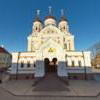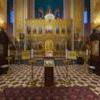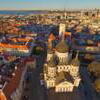

Panoramas:
 |  |  |
Date of construction: 1895 -1900 (architect Preobrazhensky)
Side-altars: North side-altar in the name of St Prince Vladimir, south side-altar in the name of St Sergius of Radonezh
Date of consecration: 30 April 1900 by Archbishop Agafangel (Preobrazhensky) of Riga and Mitava
St. Alexander Nevsky Cathedral was built in the end of XIX c. by the initiative of orthodox population and on voluntary donations raised throughout the entire empire. For collecting donations for the cathedral and construction management a special Committee was established, its chairman became prince Sergei Shakhovskoy (1852-1894), Governor of Estland. About 600 thousand roubles was needed to have the Cathedral constructed. Out of that sum 434,623 roubles and 29 kopecks were raised by September 15,1899 as donations, whereas 150,000 roubles were allocated for completion of the Cathedral from the funds of the State Treasury.
The project of the Cathedral was ordered to academician Michail Preobrazhensky (1854-1930), the adjunct-professor of the Academy of Arts. On 4 May 1893 the draft was approved and the Committee charged academician Preobrazhensky to develop a design for the five-cupola three-altar cathedral decorated in the style of ancient Russian churches and accommodating 1,500 people.
The site where the cathedral was supposed to be built was consecrated on August 30,1893, by Right Reverend Arseny, Archbishop of Riga and Mitava. For the event Puhtitsa miracle-making icon of the Dormition of the Mother of God was delivered from the Puhtitsa Dormition Convent.
As a principal contractor Ivan Gordeyev, a St. Petersburg merchant, was invited, who during that period was involved in the construction of an edifice for the district court in Tallinn. In summer 1895 they finished the foundation, basement and grouting of the socle, and proceeded with laying the walls and pylons, which were erected of local limestone bound with cement mortar and faced with Segersdorf bricks. The socle of the building was faced with Finnish granite.
On August 20,1895 Archbishop Arseny ceremoniously consecrated the laying of the cathedral.
On November 2,1897 gilded iron crosses were placed in their positions on the cupolas. All the five crosses were manufactured at Reval Roterman & Reitz mill and gilded by St. Petersburg master craftsman A. Blum. The cupolas of the Cathedral were gilded with seven layers of gold leafs. The work was done during the summer of 1898 by Petr Abrosimov, a famous St. Petersburg master of gilding craft.
Bells for St. Alexander Nevsky Cathedral were cast at the Vassily Orlov's bell foundry in St. Petersburg. All in all there are 11 cathedral bells, their total weight is about 27 tons (26,916.8 kg), with the main bell alone weighting as much as 16,288.8 kg (15,664.8 + the tongue of 624 kg). The bells were consecrated and lifted up into the belfries on June 7,1898. It required 500 soldiers with the ropes to lift up the main bell.
The facades of the Cathedral were decorated with large mosaic panels by academician A. Frolov. The facade mosaics are still unique for the Estonian architecture in both their size and craftsmanship.
Initially, according to M. Preobrazhensky's project, it was planned to place marble iconostases in the cathedral, however, during the construction works those of carved gilded wood were installed there as more corresponding to the cathedral's style following the patterns of Moscow and Yaroslavl churches of XVI-XVII cc. All the three iconostases and four icon-cases were manufactured by M. Preobrazhensky's drawings. The work was done by master craftsman P. Abrosimov, who executed the gilding of cupolas. Icons for the iconostases and four icon-cases were painted on zinc and copper panels in the St. Petersburg studio of academician Aleksander Novoskoltsev.
Windows of the main altar are decorated with stained-glass pictures and ornaments executed by St. Petersburg craftsman E. Steinke using the drawings of the academician Novoskoltsev.
The main altar-piece - "The Eucharist Sacrament" - was painted by St. Petersburg artist Michail Vassilyev on the pattern of Greek mosaic of XI c. from the main altar of the Sophia Cathedral in Kiev.
The four Evangelists on the main cupola's arches were painted by Aleksander Blaznov, the Emperor's court painter. Interior wall painting was done by painter Grigory Prokofyev after the sketches of the academician Preobrazhensky.
Two guilded copper cathedral chandeliers of the Cathedral's middle side arches are patterned in the style of the church-chandeliers of the court church in the Moscow Kremlin.
The marble covers for all the three communion tables were manufactured of white Carrara marble in the Kopiovsky's workshop in Reval and granted by Russian merchants of the town for the consecration of the Cathedral.
The new Cathedral was consecrated on April 30,1900 by Right Reverend Agafangel, bishop of Riga and Mitava, being named after faithful St. Aleksander Nevsky. For the event the Pühtitsa miracle-making icon of the Dormition of the Mother of God was delivered to Tallinn. St. John of Kronstadt took part in the ceremony of consecration. According to the long tradition the Czar's House gifted an icon to any new church consecrated in the name of a divine patron of any Russian Emperor. St. Alexander Nevsky Cathedral was donated an icon depicting 11 saints patronising the members of the Czar's family. The icon painted on a copper plate in A. Novoskoltsev's studio was dedicated to the events of October 17,1888, when Emperor Aleksander III and members of his family miraculously survived the crash of the Czar's train.
During German occupation the Cathedral was closed. In May 1945 the church services were resumed and the Cathedral once again became the focus of orthodox ecclesiastical life in Estonia. The difficult and important assignment of preparing the Cathedral to consecration and revival of church services was commissioned to Alexy Ridiger - the Patriarch of Moscow and All Russia Alexy II. As the memory of that the inscription "A. M. Ridiger 20-24 IV.1945.a." that he made on the wall of the main gallery has been solicitously preserved.
During the last decade of the XX c. the Cathedral underwent capital repairs. Facades were restored as well as the scale-like facing of cupolas was renewed (however without guilding), the metal elements of the outer decoration on the main cupola drum were replaced. Totally rusted crosses on the cupolas were replaced by new ones manufactured in St. Petersburg in full compliance with the old crosses.
Address: Lossi plats 10, 10130 Tallinn
Web site: nevskysobor.ee